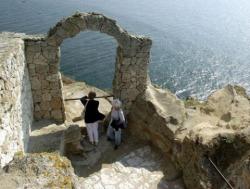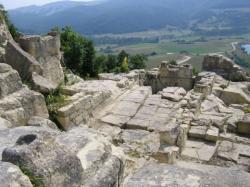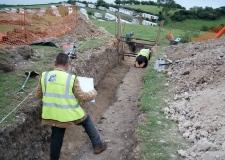- 18 AOÛT
- INDI-UNI : 
PRE-INSCRIPTION : 15 Juin – 31 Août
PRE-REGISTRATION: June 15th - August 31st
- BULGARIE –  Kaliakra cape - The archeological excavations at the Bulgarian Black Sea Kaliakra cape have been renewed at the beginning of August, immediately yielding more artifacts. The information was reported by the Head of the archeological team, Boni Pertunova, from the Bulgarian Academy of Sciences (BAS). Until now, the researchers have already discovered 20 gold objects – mostly jewelry as well as silver jewelry. They were located inside a necropolis and date from the 12th-14th century. The most interesting find has been a golden earing with two exquisite pearls, Petrunova explains. 43 tombs have been found in the area of the so-called Church 2 in Kaliakra. The most precious find there is a stamp with the portrait of the Virgin Mary. The stamp also has the monogram of its owner – a wealthy, prominent person. The latter find proves that in the 5th-6th century local residents wrote plenty of documents and correspondence, history experts say, pointing out the stamp is extremely rare and even unique.The excavations will continue at least until the end of the month since there is still a lot to research, Petrunova reports.
Kaliakra cape - The archeological excavations at the Bulgarian Black Sea Kaliakra cape have been renewed at the beginning of August, immediately yielding more artifacts. The information was reported by the Head of the archeological team, Boni Pertunova, from the Bulgarian Academy of Sciences (BAS). Until now, the researchers have already discovered 20 gold objects – mostly jewelry as well as silver jewelry. They were located inside a necropolis and date from the 12th-14th century. The most interesting find has been a golden earing with two exquisite pearls, Petrunova explains. 43 tombs have been found in the area of the so-called Church 2 in Kaliakra. The most precious find there is a stamp with the portrait of the Virgin Mary. The stamp also has the monogram of its owner – a wealthy, prominent person. The latter find proves that in the 5th-6th century local residents wrote plenty of documents and correspondence, history experts say, pointing out the stamp is extremely rare and even unique.The excavations will continue at least until the end of the month since there is still a lot to research, Petrunova reports.
http://www.novinite.com/view_news.php?id=131219
- VIET NAM – Tra Bong - Les vestiges d'une maison communale de 200 ans viennent d'être exhumés dans le district de Tra Bong, province de Quang Ngai (Centre). Ce sont les premiers résultats de fouilles archéologiques, rendus publics mercredi par l'Académie des Sciences sociales du Vietnam en collaboration avec le Service de la Culture, des Sports et du Tourisme de Quang Ngai. Des centaines d'objets dont des morceaux de briques, de tuiles doubles, des céramiques et porcelaines... datant du 18e au 20e siècles ont été trouvés sur ce site. D'après le Docteur Nguyen Tien Dong, de l'Institut national d'archéologie, ces objets suggèrent que cette maison communale de 168 m² a été construite à la fin du 18e siècle.
http://fr.vietnamplus.vn/Home/Vestiges-dune-maison-communale-de-200-ans-a-Quang-Ngai/20118/17683.vnplus
- FRANCE - Castellu di Sarravalle - Ils sont arrivés en début de mois et ne repartiront pas avant une dizaine de jours. Installés sur le site du Castellu di Sarravalle près de Calacuccia dans le Niolu, ces étudiants et anciens étudiants en archéologie fouillent méticuleusement le sol de notre montagne pour y retrouver ce qui reste de la fin de l'époque néolithique. L'an dernier sur ce même site, un fond de cabane a été trouvé. Encourageant l'archéologue Ghjuvan-Filippu Antolini a y poursuivre ses recherches. Le Niolu est très riche en ce qui concerne les sites préhistoriques. Il y en a environ 150 et seuls six ont été fouillés pour l'instant. « Comme l'occupation a duré sur de très longues périodes et que la terre a été retournée, nous trouvons aussi des céramiques d'autres époques, en particulier du Moyen-Âge. Au plus nous allons descendre, au plus nous devrions tomber sur des objets anciens. Les analyses au carbone 14 nous permettrons de les dater avec précision, même si nous avons d'ores et déjà une idée de leur époque de fabrication, notamment par rapport aux matériaux employés et aux découvertes faites en 2010 ». Pour le moment, ce sont principalement des pointes de flèches et autres céramiques qui ont été mises au jour, « ce qui montre bien que nous travaillons sur une période guerrière. Le site prouve également cela puisqu'il a un aspect défensif naturel avec ses hauts rochers et ses pentes escarpées, sans compter la proximité du fleuve qui rendait toute approche très difficile. Les abris qui ont été aménagés renforcent également ces hypothèses », précise encore Ghjuvan-Filippu Antolini.
http://www.corsematin.com/article/papier/le-niolu-neolithique-en-passe-de-reveler-certains-secrets
- BULGARIE –  Kaleto fortress - A Thracian rock sanctuary from the 5th century BC has been discovered in the Rhodope Mountains by Bulgarian archeologists. The sanctuary is in the "Kaleto" fortress site, near the village of Koshnitsa in the region of the southern city of Smolyan. This is the third Rhodope Mountain fortress with a similar find, according to Nikolay Boyadzhiev, archeologist with the Smolyan museum. The archeologists found an inside space, attached to the fortress wall, which they believe had been a watch room. The entire wall, well-preserved up to 2 meters high, has also been discovered. The fortress has an area of 2 000 square meters with 80 meters of wall revealed so far. It has been built in the 6th century AC by the Byzantine emperor Justinian to safeguard the central Roman route from the Rhodopes to Greece. The researchers also found that the fortress has been set on fire at the beginning of the 7th century by Slavic tribes. As far as the most recent find – the sanctuary, it did function until the beginning of the antique period while the fortress had been used all through medieval times and had been inhabited after the 10th century, Boyadzhiev says, pointing as proof the large number of ceramic remnants from different historical periods. Full-scale research at the site will begin in September under a joint project of the Smolyan Town Hall and partnership with neighboring Greece.
Kaleto fortress - A Thracian rock sanctuary from the 5th century BC has been discovered in the Rhodope Mountains by Bulgarian archeologists. The sanctuary is in the "Kaleto" fortress site, near the village of Koshnitsa in the region of the southern city of Smolyan. This is the third Rhodope Mountain fortress with a similar find, according to Nikolay Boyadzhiev, archeologist with the Smolyan museum. The archeologists found an inside space, attached to the fortress wall, which they believe had been a watch room. The entire wall, well-preserved up to 2 meters high, has also been discovered. The fortress has an area of 2 000 square meters with 80 meters of wall revealed so far. It has been built in the 6th century AC by the Byzantine emperor Justinian to safeguard the central Roman route from the Rhodopes to Greece. The researchers also found that the fortress has been set on fire at the beginning of the 7th century by Slavic tribes. As far as the most recent find – the sanctuary, it did function until the beginning of the antique period while the fortress had been used all through medieval times and had been inhabited after the 10th century, Boyadzhiev says, pointing as proof the large number of ceramic remnants from different historical periods. Full-scale research at the site will begin in September under a joint project of the Smolyan Town Hall and partnership with neighboring Greece.
http://www.novinite.com/view_news.php?id=131174
- ROYAUME UNI –  Beer Head - A recent archaeological dig has been unlocking Beer Head’s coastal heritage. Excavations took place from July 19 to 24, with some “interesting and exciting results,” said Kimmo Evans of East Devon AONB. Five trenches were excavated after initial surveys indicated the possible best sites. While four proved disappointing, the fifth produced evidence of an occupation layer, which indicates people having lived nearby and depositing material. A fresh look at aerial photographs, geophysical and earthwork surveys are part of the investigations that will enhance the understanding of the archaeology and history of the area. Finds included materials from the Iron Age to the 1400s. In addition to that the most interesting trench also produced local flint and iron pieces, as well as Roman Black Burnished Ware – a type of pottery. A second piece of pottery appeared to be part of a Roman tile, while a further piece was also identified as Roman because of the presence of the curve on the lip.The most exciting find was a small piece of worn Roman Samian-style ware, which is thought to have been produced in this country. “By unlocking this hidden heritage, we will be able to provide more information for all those who walk along the South West Coast Path and help tell the amazing stories of how settlements throughout history have played their role in shaping the special landscape we cherish so much today,” said Pete Youngman of East Devon AONB.
Beer Head - A recent archaeological dig has been unlocking Beer Head’s coastal heritage. Excavations took place from July 19 to 24, with some “interesting and exciting results,” said Kimmo Evans of East Devon AONB. Five trenches were excavated after initial surveys indicated the possible best sites. While four proved disappointing, the fifth produced evidence of an occupation layer, which indicates people having lived nearby and depositing material. A fresh look at aerial photographs, geophysical and earthwork surveys are part of the investigations that will enhance the understanding of the archaeology and history of the area. Finds included materials from the Iron Age to the 1400s. In addition to that the most interesting trench also produced local flint and iron pieces, as well as Roman Black Burnished Ware – a type of pottery. A second piece of pottery appeared to be part of a Roman tile, while a further piece was also identified as Roman because of the presence of the curve on the lip.The most exciting find was a small piece of worn Roman Samian-style ware, which is thought to have been produced in this country. “By unlocking this hidden heritage, we will be able to provide more information for all those who walk along the South West Coast Path and help tell the amazing stories of how settlements throughout history have played their role in shaping the special landscape we cherish so much today,” said Pete Youngman of East Devon AONB.
http://www.sidmouthherald.co.uk/news/news/beer_head_dig_unlocks_coastal_heritage_1_994222
- FRANCE – Bidart - Un diagnostic archéologique est programmé à Bidart à partir du 12 septembre et pour une durée de dix jours. L’Institut national de recherche archéologique préventive (INRAP) intervient lors de l’aménagement d’un terrain, dans un souci de préservation du patrimoine archéologique menacé par des opérations de construction. A Bidart, pour faire suite au contrat de bassin signé le 7 juillet dernier et qui entend améliorer la gestion des flux de l’Uhabia, des travaux d’assainissement et hydrauliques sont prévus. Ainsi, des tranchées seront réalisées par l’INRAP sur trois secteurs : la plage de l’Uhabia, la future canalisation, et les deux zones du bassin, pour une surface totale de plus de 3,5 hectares. Sont attendues des occupations humaines pour une période chronologique s’étalant de la fin du Paléolithique, la première et plus longue période de la préhistoire qui commence avec l’apparition humaine, il y a environ 3 millions d’années, jusqu’à la protohistoire, qui correspond à l’âge de bronze et du fer. Quant aux périodes historiques, les fouilles vont peut-être permettre de retrouver des traces de l’ancien port de pêche de Bidart, qui s’étend sous la plage de l’Uhabia.
http://www.lejpb.com/paperezkoa/20110818/285451/fr/Intervention-imminente-l%C2%92INRAP-a-l%C2%92Uhabia-a-Bidart